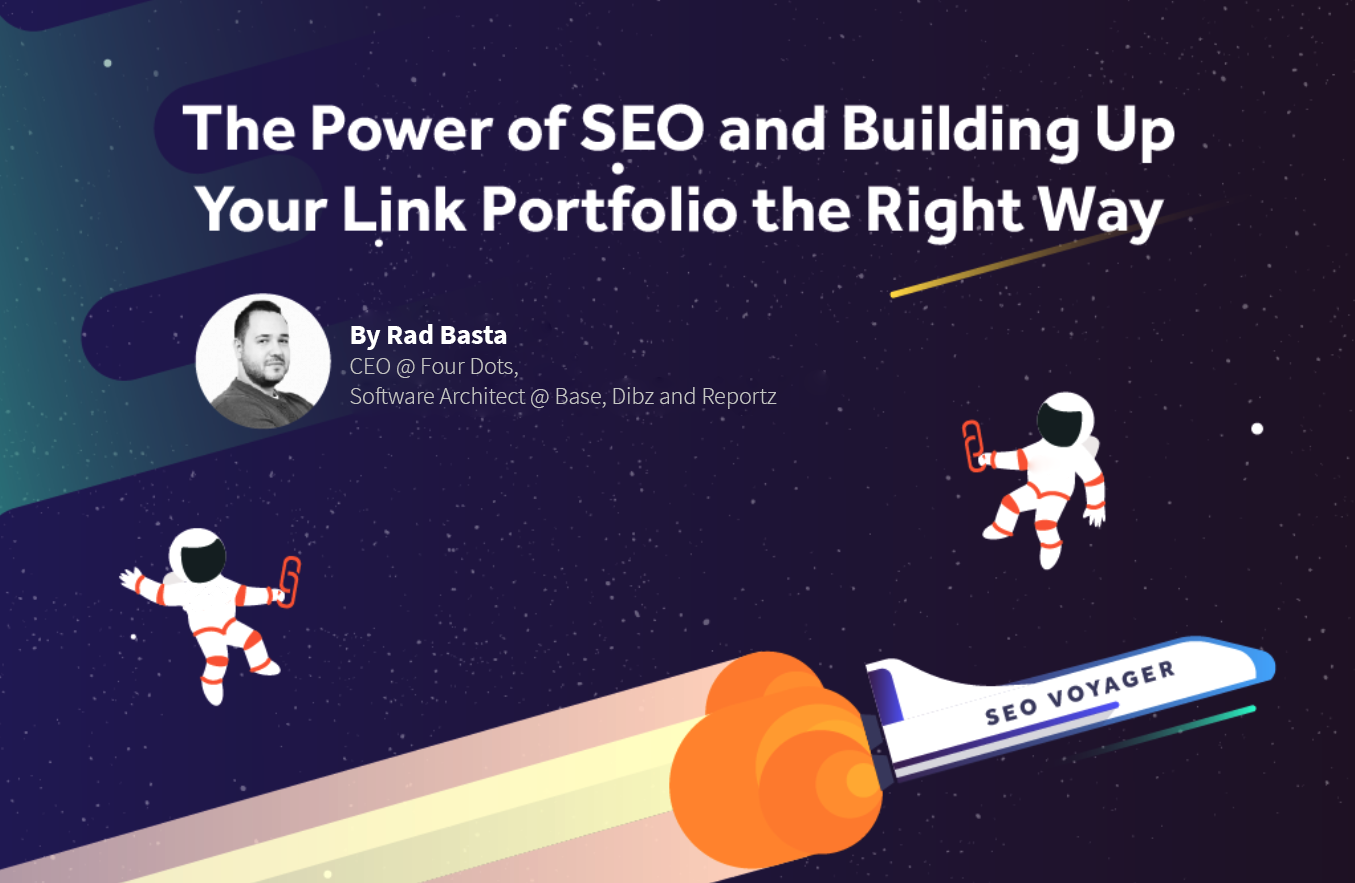Without further delay, let's dig in!
The Restless Expansion of the Internet and the Ever-Growing Importance of Developing a Noticeable Online
Presence
The world is developing at an increasing speed. Especially from a technological point of view. In this day
and age, close to 2.5 billion people use smartphones. If you do the math, you’ll figure out that’s just a
little bit over 36 percent of the world’s entire population.
Impressive, right?
And that’s just smartphones. What about other devices? What about tablets, laptops, desktop computers and
all the other gadgets that now play a huge part in our daily routine?
Life has become vigorously computerized. People now communicate through social apps and email, organize
daily tasks with the help of different tools, buy clothes online, stream business operations and logistics
through different software - the list goes on and on.
Numerous researches predict that by the end of the year of 2020, a generation will have grown up in an
entirely digital world, meaning they won’t remember a time without computers, smartphones, or the Internet.
This particular generation is going to be entirely dependent on technology and advanced communication and
information tools, both from social and from the business point of view.
Technology has changed our lives forever. The Internet alone has turned our world upside down and
transformed how we think, interact, work and consume. By providing us with an endless sea of information and
resources, the Internet has given us an opportunity to connect with the entire world and learn almost
everything we want, just by using our fingertips.
A lot of people now embrace and accept digital transformation. Even the biggest skeptics understand the
value of the Internet and its influence on our day-to-day lives.
However, a lot of people still fail to see the bigger picture. Especially those who are still struggling to
understand the value of working on their online presence and securing top positions in search for their
brand or products.
The expansion of technology and the Internet has affected 3 major areas of how we think and do business:
-
Consumerism - the Internet has forever changed how consumers think and interact with brands. It
shifted the focus to the never-ending need for instantly available, high-quality information, products,
and services. Modern consumers are looking to make educated purchasing decisions. Before they commit to
a single option, they first search the Web and look at all the offers. Once they’ve examined all the
options and learned everything they could about the service or product providers, only then do they
select the one they’ll give their trust to.
Consumers have more options now than ever before. They can do business with people and brands they
genuinely like and respect. The Internet has made it possible for them to weigh their options. They are
aware of their power and they know that brands will bend over backward to provide them with everything
they demand to make their shopping experience as pleasant as possible.
Aside from good service, brands are also obliged to provide relevant information, discuss topics online,
develop loyalty programs, as well as do everything that can spark engagement and develop trust between
them and their potential shoppers.
This is happening because the Internet has allowed people to do business globally. Everything is
accessible now, which is a direct reason why most brands are forced to constantly go head-to-head with
each other for the same customers.
-
Digitalization - The quickening pace of the introduction of technological innovations has
influenced the creation and improvement of various digital channels. This, of course, led to the
reduction of the cost of owning and creating digital products and businesses. More and more
entrepreneurs have acknowledged the value and cost efficiency of operating online, so they abandoned all
traditional brick and mortar setups that would normally monopolize their budgets. A lot of them have
made the full move to digital.
-
Economics - The age of hyper-connectivity and digitization has brought us significant financial
perks and enabled the creation of new, often revolutionary technologies. Catching the wave of change in
its earliest phases and making the most of new tech solutions is incredibly rewarding, both for
companies and for consumers.
As you can see from everything written above, the ever-growing power of the Internet and technology has
drastically changed how people consume and how they do business. We are living in the age of instant
information. Google now processes more than
3.5 billion searches per day. That means that every second of every day, the engine responds to more than 40.000 queries from users
around the globe.
That's a lot.
Digitalization and the expansion of the Internet have created a culture of endless choices and millions of
competing messages. This is a double-edged sword for everyone who wants to do business online. It is
becoming increasingly difficult for businesses to promote their brand and make sales online. Even though
Google conducts over 1.2 trillion searches per year worldwide, people are still struggling to break through
the noise, reach their targeted audiences and provoke engagement.
Gaining an edge on the competition has become a lot harder, but it’s still possible. With a little bit of
strategy and understanding of the digital landscape, there’s a legitimate chance for brands to rise above
their competitors and reach the right type of Internet users that have a high degree of probability of
becoming their actual paying customers.
This is where SEO comes to shine.
The Mechanics of SEO
As we mentioned in our first guide, titled “Every Damn Thing You Need to Know About Backlinks”, SEO is all about helping your brand reach the right type of audience. It’s an ongoing process that
helps you truly harness the full power of the Internet and make it your ally.
If you imagine Google as a giant store, any type of store - quality SEO would be the process of convincing
the manager/owner of that establishment to place your product in the store’s window.
That way, it attracts attention as it is the first thing people see before stepping into the store. If you
do your part right and make this product exciting enough - you’re probably going to make sales.
On the other hand, if you don’t do a good job of communicating the value of your products, that same owner
will treat your merchandise as garbage and place it in the back, where most customers don’t ever go.
You don’t want that. Your goal is to grab your potential customers’ attention and remain in their eyesight.
The same goes for your position in search, hence you need to invest a lot of time and effort into the
optimization of your website for SERPs.
That is basically what SEO is all about. Search engine optimization is the process of earning and retaining
good positions in Google’s search. It combines many techniques and strategies that could help you rise to
the top of Google’s SERPs for your most lucrative keywords.
If you’re in need of a more detailed explanation, there are numerous guides online that can teach you
everything you need to know about search engine optimization.
For example, MOZ has a great and extremely detailed guide about the
fundamentals of SEO
that is great for beginners.
But enough about that, let’s go back to our story:
Regardless of what you’re trying to achieve online, the no.1 goal of every digital marketing strategy
directly or indirectly revolves around generating relevant traffic. You don’t just want any type of visits
to your site. No. Your goal should be to chase traffic that has the most potential to result in conversions
and sales. The idea is to get as many visits as possible from the people who actually have an interest in
what you do and what you have to offer.
With a little bit of intelligent planning and a lot of hard work, you can achieve that with SEO. If you lay
down the right foundation for your strategy, you’ll be able to improve your rankings in Google search and to
position your website above thousands of other sites which are after the same traffic as you.
The Onsite and Offsite Sides of SEO
As you probably already know, search engine optimization is a term used to group and explain a series of
different activities that can help users easily find your website and pages in search. Apart from that,
these activities also help Google better understand your content and how to calculate your relevance for
the topics and keywords you’re trying to rank.
In order to understand all the searches and figure out how to present their users with the best possible
results for specific queries, search engines look at a variety of different factors. Google alone currently
uses more than
200 different ranking factors
to determine how to organize its results. Even though some are proven and others are just speculated about,
every single one of these ranking factors is at least worth looking into.
The details of Google’s inner workings are still a mystery. The company has done a pretty good job of
keeping their formula a secret. However, SEO experts have noticed numerous different things which can be
considered reliable and
legitimate tips and tricks for improving rankings in search.
Google itself has hinted at many of these factors through its numerous algorithm update announcements.
Regardless of what you’re trying to achieve, it’s imperative to keep these 200 factors in mind when
developing and optimizing your site for organic search visibility. As you’ll see when you open the list, all
of those factors can be divided into two groups:
-
Onsite - Direct modifications to your website and pages, with the goal of making them
Google-friendly.
-
Offsite - External factors crucial for promoting your website in search and generating more quality
traffic. For instance, link building is an offsite tactic.
The whole onsite SEO game revolves around making it easier for Google bots to crawl your website and pages,
and to determine how, where and for what to rank you in the search.
The Noob-Friendly Onsite SEO Checklist
If you’re interested in creating a perfectly optimized page, you need to focus on the following elements:
-
Title tag - this is one of the most important onsite SEO factors. You need to tell the engine and
the users what it is that you want to rank for. Use your main keyword in the title tag and try to keep
it as close as possible to the beginning of the title, because that way it will have more weight with
the search engine.
-
URL - Make sure that your URLs are short, sweet, and keyword rich. Shorter URLs rank better in
search.
-
Headings - Google looks at H1 and H2 to learn about pages. They are an extremely important onsite
SEO factor and should be used in proper order. Make sure to first insert your H1 tags. It’s not
advisable to place H2 at the top of your pages. H1 and H2 should also contain keywords that are relevant
to the content of that particular page.
-
Multimedia - The engines like videos, images, and other types of media that enrich the user's
experience of a particular page. They are known for decreasing bounce rates and improving site
retention.
-
Image alt text - Apart from providing alternative information for images that cannot be viewed by
users for any number of reasons, alt attributes help Google understand what a particular picture is
about and how to rank it in image search.
-
Keyword density and placement - Practice has shown that a targeted keyword shouldn’t be used so
frequently on a page as to account for more than 2-4 percent of its total word count, tops. When it
comes to placement, the main keyword should appear somewhere in the first 100 words of the content.
-
Responsive design - Google recently rolled out a new
mobile-first indexing
update, which is the company's latest effort to make the web more accessible to users who primarily use
the world’s most popular search engine on their mobile devices. The mobile version of your site is now
the first thing Google looks at when indexing your domain and pages and awarding you with rankings. This
means that you need to do a terrific job of making your content, data structure, metadata, and
everything else responsive and mobile-friendly.
-
Internal and external links - Pages need links. Contextually connecting your page to related
outside sources is a relevancy signal that helps the world’s most popular search engine understand your
page’s topic. Just like the outbound, internal links are also valuable ranking elements. You can use
them to direct the link juice flow on your site and intelligently promote your homepage or pricing
pages. As a site admin, you have the power to create the structure that works best for your business by
sending link equity to the pages that mean the most to you.
-
Speed - Last year,
Google announced
that page loading speed is one of many factors that they look at when calculating how to rank those
pages in search. It is speculated that Google might be measuring time to the first byte when determining
the overall speed of pages. Having a slow page means that Google spiders will have difficulties crawling
your content, which could negatively affect your indexation. Use the
PageSpeed Insights
tool to determine the speed of your page. If it’s below average, you might need to compress your images
or talk to the people who are hosting your site.
-
Quality content - If you want a page to rank well, you need to fill it with high-quality,
original content. If you provide unique points about a chosen subject and write in accordance with all
the
SEO copy/content writing rules, you’ll have something that Google will most likely love.
-
Duplicate content - Usually either refers to stolen content, i.e. copied from another website and
republished without any significant changes; or to similar or identical text found on a number of your
own pages. The former used to be a much bigger problem before Panda got efficient in penalizing link
farms and other offenders, but the latter can still be an issue if you are not careful. Luckily, there
are a number of ways to deal with duplicate content, including blocking in Robot.txt, using meta robots
to assign noindex/follow tags, 301 redirects, canonical link tags, etc.
-
Sitemap - A sitemap is an important part of every website. Sitemaps make it easier for visitors
to navigate websites and they inform the search engines what the content on a page is about, how often
it is being updated and how important it is when compared to other pages on the website. They help
search engines understand the structure of the site and its links, which enables better and faster
crawling.
-
Keyword mapping - If you want to get on the engine’s good side, you need to invest quite a bit of
time and effort into keyword mapping. This involves pairing the keywords you want to rank for in
Google’s SERP with suitable, existing pages of your website, or just simply creating new pages and
content with those keywords in mind. It is an essential element of every SEO strategy as it helps you
improve your positioning in the SERPs and promote your values and relevance for particular queries as
strongly as possible.
-
Fetch as Googlebot - Even though this isn’t really a ranking signal, it’s important that I
mention this tool in this particular part of the article.
Fetch as Googlebot
is a free utility that enables web admins to test how Google crawls their websites. Using this sweet
tool, you’ll be able to understand how the engine sees and renders your pages. You’ll see if specific
resources are blocking Googlebots and making it hard for them to do their job. Once you identify all the
crawling errors, you’ll know what you need to do to make it easier for the search engine to read your
pages.
That’s it for the onsite part of SEO. Of course, there’s a lot more to be said on the subject, but I’ll save
that for another time. These are just the fundamentals, the basics to help you get started.
The Fundamentals of Offsite SEO
Even though I talked about onsite first, offsite is just as important. In a nutshell, offsite SEO refers
to actions that you take outside of your website to improve its rankings in Google’s search. It can be
more demanding than optimizing your onsite performance as it requires a lot of hard work and doesn’t
revolve solely around you.
This process requires you to build up your relevance, authority, and trustworthiness in both the users’ and
the engine’s eyes. Creating “off the page” resources that complement your “on page” efforts is the best way
to improve your search engine rankings for relevant keywords. Offsite is mainly focused on promotion and on
building relevant connections that increase the authority of your existing onsite elements.
Having that in mind, you could almost say that most offsite SEO strategies basically boil down to link
building. Of course, you could do a lot more to influence your offsite SEO performance apart from building
links for your domain and pages, but this is the most important and the most efficient strategy for earning
better positions in search.
Links are the glue that holds web pages together. Even though the mechanics of how Google works still remain
a mystery for the most part, we are 100 percent sure that the engine uses links to determine the value of a
particular piece of content, page or a website.
Regardless of the fact that earning high-quality links for your domain or specific pages sounds like a
pretty straightforward plan, in reality, it’s a lot more complicated than most people think.
As you probably know, not all links are created equal. The amount and type of value that they are bringing
to your site can vary quite a bit.
If you want to achieve success with your link building and outrank your direct and indirect competitors, you
need to bulk up your backlink portfolio.
And I mean really bulk it up.
Better links from better resources - that’s the only way to rise above your rivals in search, assuming that
your onsite SEO game is on point.
Generating a steady flow of quality inbound links is a process that demands a lot of up-front thinking and
planning.
Finding adequate link prospects can be difficult enough on its own. This is why we wrote a guide dealing
with
link prospecting and link building through guest blogging. If you read the guide, you’ll see that searching for relevant link opportunities is an exhausting process
that requires a lot of manual work. Apart from turning the entire Web inside out to find opportunities, you
also need to organize them according to relevance or other criteria.
Link building is among the essential components of any effective SEO strategy. In order to optimize your
link-building workflow, you need to improve and speed up Link Management processes. The industry standard
for these tasks has so far involved using Google Sheets. Lots and lots of sheets, docs and tables that
create a complex and messy ecosystem of records, sheets and reports, providing heavy and long-lasting
headaches even to the most organized SEOs.
This is where Base comes to save the day.
Thanks for taking the time to read this massive post from top to bottom, I hope it helped you better
understand the need and value of improving your authority and visibility in Google’s SERP.
See you again soon,
Rad @ Base.me

 We fixed link building
We fixed link building We fixed link building
We fixed link building We fixed link building
We fixed link building We fixed link building
We fixed link building Use cases
Use cases Outreach
Outreach Buying links
Buying links Selling links
Selling links Features
Features Backlinks Health Check
Backlinks Health Check Link Building API
Link Building API Blacklisted Links
Blacklisted Links Easily Sell Links
Easily Sell Links SEO Metrics by Ahrefs
SEO Metrics by Ahrefs Chrome extension
Chrome extension Link Building Database
Link Building Database Team Management Tool
Team Management Tool SEO Reporting Dashboard
SEO Reporting Dashboard Index Your Backlinks
Index Your Backlinks LB Outreach Management
LB Outreach Management Expiring Links Alerts
Expiring Links Alerts Automatic SPAM Analysis
Automatic SPAM Analysis Link Building Transparency
Link Building Transparency Google Link Index Checker
Google Link Index Checker Manage External Link Builders
Manage External Link Builders